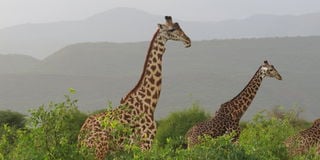Giraffe meat craze nightmare for KWS in Garissa

There is an increase in poaching of giraffes in Garissa and Wajir counties.
What you need to know:
- “We have people talking of having improved sexual desire when they eat the giraffe meat. This is not true. These people are only killing giraffes for meat and nothing else,” said Jacob Ilo Orahle, the Garissa County Senior Kenya Wildlife Service (KWS) warden.
- “We are having an increase in poaching in Garissa and Wajir counties because of the presence of refugees. They go for these wildlife because they don’t have domestic animals," he added.
The lack of domestic animals and cultural beliefs have driven locals of Garissa into hunting and feeding on wildlife in the recent past.
The giraffe and antelope are the most affected animals in the area.
The presence of refugees in the county has been blamed for the vice.
“We are having an increase in poaching in Garissa and Wajir counties because of the presence of refugees. They go for these wildlife because they don’t have domestic animals to rely on for meat and milk,” said Jacob Ilo Orahle, the Garissa County Senior Kenya Wildlife Service (KWS) warden.
The refugees, the majority being from Somalia, have settled in the Dadaab refugee complex, exerting pressure on local resources.
“Giraffes are the most targeted because of their body size. It has more meat which the poachers sell within the refugee camp,” Orahle said.
Read: Seven in 10 rural Kenyans eat wild meat, ILRI study reveals
On Tuesday, police from the Dagahaley Refugee Camp arrested four men who had killed a giraffe for game meat.
The incident happened at Kumahumato village within the Dadaab Refugee Complex.
According to Orahle, poaching is at a high rate in Garissa.
“We are getting reports of giraffes being killed every week in areas near the refugee camp. We are carrying out public awareness to sensitise them on the importance of wildlife,” Mr Orahle said.
Despite locals attributing poaching to some cultural beliefs in Garissa, Mr Orahle said there is no scientific research to prove that.
“We have people talking of having improved sexual desire when they eat the giraffe meat. This is not true. These people are only killing giraffes for meat and nothing else,” Orahle said.
Read: Kenyans eating giraffe meat disguised as beef, conservationists say.
Mr Ali Dekkow, a local, claimed that giraffe meat is in high demand because it boosts sexual desire.
“Some people are eating giraffe meat so that they can have better performance in bed. I tried it and I can confirm I was better,” he said hilariously.
Mr Abdi Ibrahim, the chairman of Garissa County Ecotourism Conservation Association called for heightened surveillance in the area in efforts to curb poaching.
“The cases of traditional hunters in the camps poaching the endangered giraffe are rampant and we will not hesitate to sensitise the community on the importance of protecting our natural resource,” he said.
He challenged the local refugee host community to be vigilant and report poaching incidences.
Read: Somali nationals entering Kenya for game meat poaching
“The refugees will go back to their homes after finishing your natural resources, let us collectively join hands to fight poaching,” he said.
In March 2020, Kenya’s only white female giraffe and her calf were killed by poachers at Ishaqbini Hirola Community Conservancy in Ijara.
The white giraffe made headlines in 2017 after its discovery with its unique white hide. It was white but not albino due to a condition known as leucism.
Unlike albinism, animals with leucism continue to produce dark pigment in their soft tissue, hence, her eyes were dark.
At least nine species are found in Africa and three in Kenya.
The three are the reticulated giraffe, also known as the Somali giraffe, Rothschild’s giraffe and the Masai giraffe.
Giraffes are killed for bushmeat, body parts and hides for the domestic and international markets.
On August 22, 2019, the giraffe species were granted more protection under laws protecting iconic species during a resolution passed at the meeting of the 18th Conference of Parties to the Convention on International Trade in Endangered Species (CITES CoP 18).
Giraffes are listed on CITES Appendix II. The appendix includes species not necessarily threatened with extinction but in which trade must be controlled to avoid utilisation incompatible with survival.
The proposal was put forward by the Central African Republic, Chad, Kenya, Mali, Niger and Senegal.





